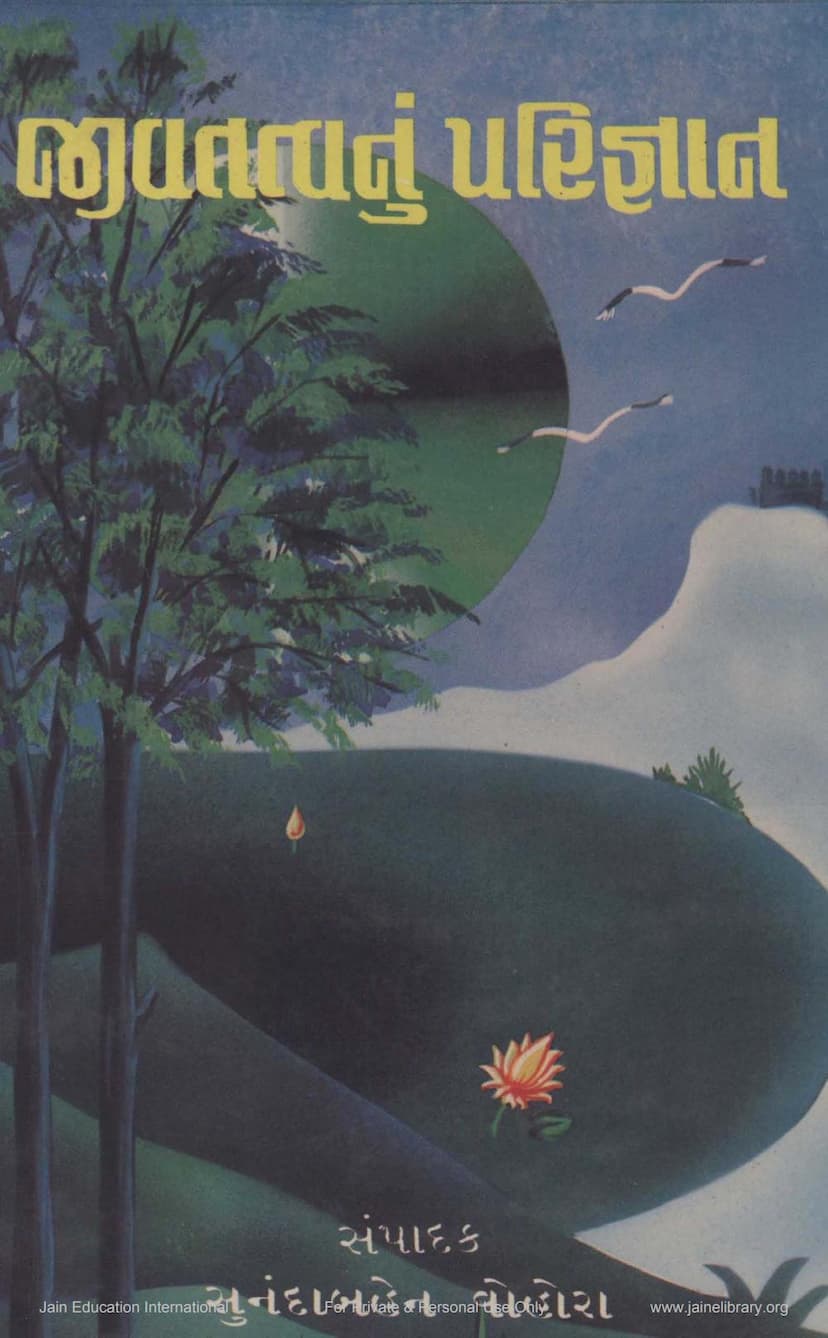Jiva Tattvanu Parigyan
Added to library: September 2, 2025

Summary
This document is a Jain text titled "Jiva Tattvanu Parigyan" (Knowledge of the Soul/Living Beings) by Sunandaben Vohra, published by Somchand D Shah. The book is a comprehensive guide to understanding the Jain perspective on the universe, life, and the path to liberation.
Here's a summary of its key aspects based on the provided pages:
Core Philosophy and Purpose:
- Emphasis on Ahimsa (Non-violence): The book strongly advocates for compassion and non-violence towards all living beings, from the smallest to the largest. It highlights the Jain principle of "Live and let live, live and help live."
- Understanding Life to Prevent Harm: The primary purpose is to educate readers about the vastness and diversity of life (Jiva Srishti) so they can understand the pain they might inflict and strive to avoid it.
- Spiritual Development: The ultimate goal is to guide individuals towards self-realization, detachment from worldly desires, and ultimately, liberation (Moksha) from the cycle of birth and death.
- Guidance from Scriptures: The text emphasizes the importance of studying Jain scriptures (Agams) and seeking guidance from enlightened beings (Gurus) for true understanding.
Key Concepts Covered:
-
The Universe and Its Structure (Lokas):
- The Jain cosmology describes the universe as a fourteen-rajju structure, divided into three main parts: Adholok (lower world, where hellish beings reside), Tiryanchlok (middle world, including earth, where humans and animals live), and Urdhvalok (upper world, where celestial beings reside).
- The Trasnadi is a central channel within the universe where mobile (Trasa) beings exist, while immobile (Sthavar) beings, including microscopic organisms, densely populate the rest of the universe.
- Siddhashila is the highest point where liberated souls reside.
-
Types of Souls (Jivas):
- Siddha: Liberated souls, who are free from all karma, possess infinite knowledge, perception, bliss, and power. They reside in Siddhashila.
- Samsari: Souls still bound by karma, transmigrating through different life forms and realms.
-
Classification of Living Beings:
- Sthavar (Immobile): Beings with only one sense of touch. This includes:
- Prithvi-kaya: Earth bodies (earth, gems, metals)
- Ap-kaya: Water bodies (water, dew)
- Teu-kaya: Fire bodies (fire, heat)
- Vayu-kaya: Air bodies (wind, air)
- Vanaspati-kaya: Plant bodies (one-sensed plants). These are further divided into:
- Sadharan Vanaspati-kaya: Common plant bodies, where one physical form hosts infinite souls (known as Nigod).
- Pratyek Vanaspati-kaya: Individual plant bodies, each with one soul.
- Trasa (Mobile): Beings with two or more senses. This includes:
- Dvi-indriya: Two-sensed beings (touch, taste) - e.g., worms, shells.
- Tri-indriya: Three-sensed beings (touch, taste, smell) - e.g., ants, lice.
- Chau-indriya: Four-sensed beings (touch, taste, smell, sight) - e.g., flies, mosquitoes.
- Panch-indriya: Five-sensed beings (touch, taste, smell, sight, hearing). These are further divided into:
- Naraka: Hellish beings (extreme suffering due to past karma).
- Tiryancha: Animals and lower life forms (often driven by senses and instinct).
- Manushya: Humans (possess intellect and the potential for liberation).
- Deva: Celestial beings (enjoy heavenly pleasures but are also bound by karma and eventually reincarnate).
- Sthavar (Immobile): Beings with only one sense of touch. This includes:
-
Life Processes and Bodies:
- Pranas (Life Forces): Discusses vital energies that sustain life, including senses, mind, speech, body, and lifespan.
- Paryapti (Completeness/Development): The process by which a soul develops its physical and sensory faculties. It covers the development of food, body, senses, breath, speech, and mind.
- Bodies (Sharir): Explains the different types of bodies a soul can possess: Audarika (gross physical), Vaikriya (transformable), Aharaka (manifested), Taijasa (fiery), and Karmana (karmic).
- Stature (Sansthan) and Bone Structure (Sanghan): Details the different body shapes and the strength of skeletal structures in living beings.
-
Karma and Its Effects:
- Karma: The fundamental principle that actions create consequences, shaping a soul's rebirths and experiences.
- Types of Karma: Explains the eight types of karma and their specific effects on the soul's qualities (knowledge, perception, bliss, power, lifespan, form, status, obstruction).
- Bonding of Karma: Discusses how passions (kashayas - anger, pride, deceit, greed), ignorance (mithyatva), lack of control (avirati), negligence (pramada), and activities (yoga) lead to karma bondage.
- Destruction of Karma (Nirjara): Outlines methods for shedding karma, primarily through austerities (Tapa) and virtuous conduct.
-
The Path to Liberation (Moksha Marg):
- The Nine Tattvas (Principles): Explains the fundamental truths of Jainism: Jiva (soul), Ajiva (non-soul), Punya (merit), Pap (demerit), Ashrav (influx of karma), Samvar (cessation of karma influx), Nirjara (shedding of karma), Bandha (bondage of karma), and Moksha (liberation).
- The Three Jewels (Ratnatraya): Right Faith (Samyak Darshan), Right Knowledge (Samyak Gyan), and Right Conduct (Samyak Charitra) are presented as the essential path to liberation.
- Leshyas (Mental Dispositions): Describes the six types of Lèshyás (Krishna, Nila, Kapot, Tejo, Padm, Shukla) as the mental states that influence karma and the soul's experiences, with Shukla Lèshyá being the most conducive to liberation.
Overall Tone and Message:
The book is written with a devotional and instructive tone, aiming to instill ethical values and spiritual understanding in its readers. It encourages introspection, compassion, and diligent practice of Jain principles. The inclusion of quotes from Acharya Shri Bhadrankarsurishwarji and Pujya Shri Nandishthaji, along with illustrations, makes the complex philosophical concepts more accessible. The recurring theme is the importance of gaining knowledge about the soul and the universe to live a life of minimal harm and maximum spiritual progress.